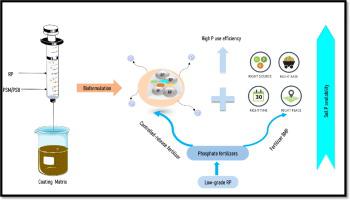Journal of Advanced Research ( IF 11.4 ) Pub Date : 2021-08-23 , DOI: 10.1016/j.jare.2021.08.014 Wissal Elhaissoufi 1, 2 , Cherki Ghoulam 1, 2 , Abdellatif Barakat 1, 3 , Youssef Zeroual 4 , Adnane Bargaz 1

|
Background
Increasing crop production to feed a growing population has driven the use of mineral fertilizers to ensure nutrients availability and fertility of agricultural soils. After nitrogen, phosphorus (P) is the second most important nutrient for plant growth and productivity. However, P availability in most agricultural soils is often limited because P strongly binds to soil particles and divalent cations forming insoluble P-complexes. Therefore, there is a constant need to sustainably improve soil P availability. This may include, among other strategies, the application of microbial resources specialized in P cycling, such as phosphate solubilizing bacteria (PSB). This P-mediating bacterial component can improve soil biological fertility and crop production, and should be integrated in well-established formulations to enhance availability and efficiency in use of P. This is of importance to P fertilization, including both organic and mineral P such as rock phosphate (RP) aiming to improve its agronomic efficiency within an integrated crop nutrition system where agronomic profitability of P and PSB can synergistically occur.
Aim of Review
The purpose of this review is to discuss critically the important contribution of PSB to crop P nutrition in concert with P fertilizers, with a specific focus on RP. We also highlight the need for PSB bioformulations being a sustainable approach to enhance P fertilizer use efficiency and crop production.
Key Scientific Concepts of Review
We first recognize the important contribution of PSB to sustain crop production, which requires a rational approach for both screening and evaluation of PSB enabling an accurate assessment of the bacterial effects both alone and in intertwined interaction with plant roots. Furthermore, we propose new research ideas about the development of microbial bioformulations based on PSB with a particular focus on strains exhibiting synergetic effects with RP.
中文翻译:

磷酸盐细菌溶解:实现更高磷利用效率和作物生产力的关键根际驱动力
背景
增加作物产量来养活不断增长的人口已经推动了矿物肥料的使用,以确保农业土壤的养分供应和肥力。在氮之后,磷 (P) 是植物生长和生产力的第二重要营养素。然而,大多数农业土壤中的磷利用率通常是有限的,因为磷与土壤颗粒和二价阳离子强烈结合,形成不溶性磷复合物。因此,需要持续改善土壤磷的有效性。除其他策略外,这可能包括应用专门用于 P 循环的微生物资源,例如磷酸盐溶解细菌 (PSB)。这种 P 介导的细菌成分可以提高土壤生物肥力和作物产量,
审查目的
本综述的目的是批判性地讨论 PSB 与磷肥一起对作物磷营养的重要贡献,特别关注 RP。我们还强调了 PSB 生物制剂作为提高磷肥使用效率和作物产量的可持续方法的必要性。
审查的关键科学概念
我们首先认识到 PSB 对维持作物生产的重要贡献,这需要一种合理的方法来筛选和评估 PSB,从而能够准确评估单独和与植物根系相互作用的细菌效应。此外,我们提出了关于开发基于 PSB 的微生物生物制剂的新研究思路,特别关注与 RP 具有协同作用的菌株。









































 京公网安备 11010802027423号
京公网安备 11010802027423号